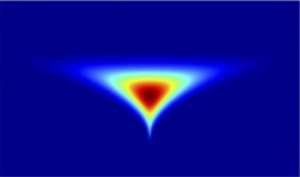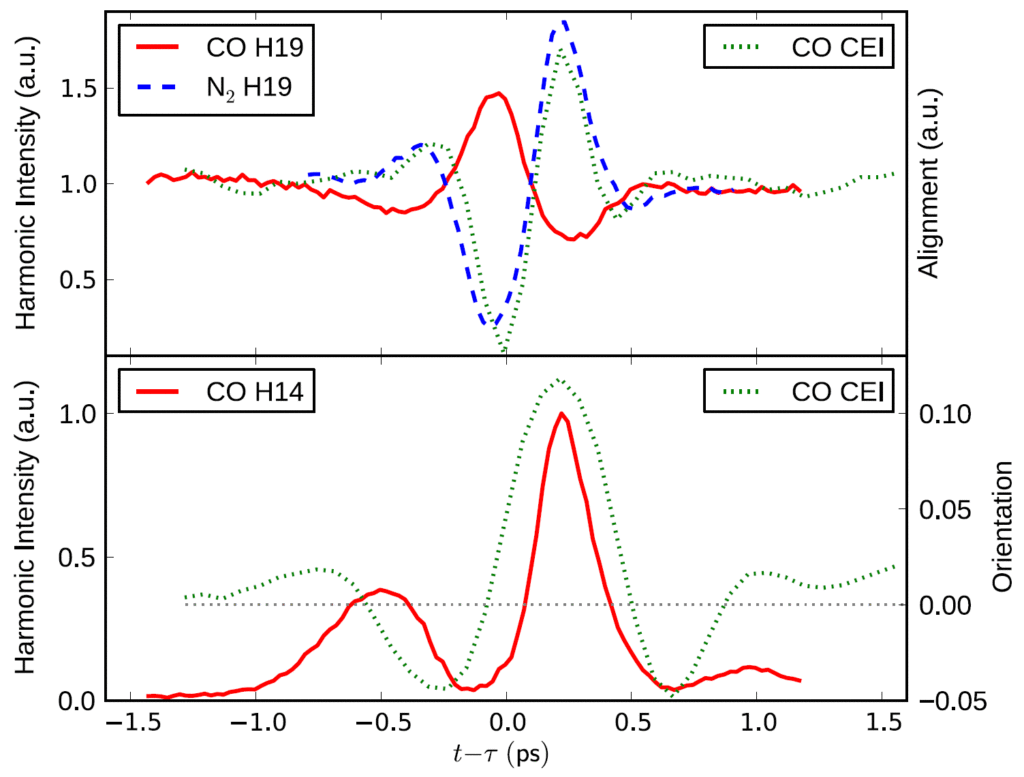Welcome – Frumker Group
 |
In our group, we focus on both experimental and theoretical studies at the interface of ultrafast nonlinear optics, attosecond science, quantum optics and nanoscience. More specifically, our work involves generation, measurement and control of the interaction of light and matter in atoms, molecules and nanosystems in space and time at extremely short, up to attoseconds (~attosecond=10^(-18)sec) time scale. Our interests range from fundamental physical phenomena associated with these processes to practical applications. |
 |
Research Highlights
- New measurement and process control concepts are critical for the future advances in the areas of quantum electronics, quantum computing and information processing. We investigate new approaches of using HHG for multidimensional nanotomographyto address these challenges.
- Accurately characterizing the intensity and duration of strong-field femtosecond pulses within the interaction volume is crucial for attosecond science. However, this remains a major bottleneck, limiting accuracy of the strong-field, and in particular, high harmonic generation experiments.We present a novel scheme for the in situ measurement and control of spatially resolved strong-field femtosecond pulse intensity and duration within the interaction focal region. Our approach combines conjugate focal imaging with in situ ion measurements using gas densities pertinent to attosecond science experiments.
- The carrier-envelope phase (CEP) plays an increasingly important role in precise frequency comb spectroscopy, all-optical atomic clocks, quantum science and technology, astronomy, space-borne-metrology, and strong-field science. Hitherto, in majority of studies it has been essentially assumed that CEP is strictly a temporal phenomenon. We introduce a new approach for the space-time calculation of the CEP. We find a significant variation of CEP in the focal volume of refracting focusing elements and accurately calculating its value. Our method is particularly suitable for application to complex, real-world, optical systems, thereby making it especially useful to applications in research labs as well in the engineering of innovative designs that rely on the CEP.
- Detailed experimental characterization of the generating medium density distribution is essential for optimization of the attosecond pulse generation process, and the acquisition of a more profound understanding of the underlying physical phenomena. To address this challenge, we demonstrated a new type of in-situ dynamic four-dimensional (4D=3D space + 1D time) laser induced strong field ionization tomographic imaging approach. Our methodology facilitates systematic quantitative measurements with exceptional spatial and temporal resolutions, suitable for both basic and applied research in far-from-equilibrium systems, including supersonic and hypersonic pulsed gas jets.
-
In situ characterization of laser-induced strong field ionization phenomena
Accurately characterizing the intensity and duration of strong-field femtosecond pulses within the interaction volume is crucial for attosecond science. However, this remains a major bottleneck, limiting accuracy of the strong-field, and in particular, high harmonic generation experiments.We demonstrated a novel scheme for the in situ measurement and control of spatially resolved strong-field femtosecond pulse intensity and duration within the interaction focal region. Our approach combines conjugate focal imaging with in situ ion measurements using gas densities pertinent to attosecond science experiments. Independent measurements in helium and argon, accompanied by a fitting to a strong field ionization dynamic model, yield accurate and consistent results across a wide range of gas densities and underscores the significance of double ionization, as well as barrier suppression ionization. Direct spatially resolved characterization of the driving laser is a critical step towards resolving the averaging problem in the interaction volume, paving the way for more accurate and reliable attosecond experiments.
The accuracy of strong-field experiments, particularly in attosecond science, should no longer be constrained by uncertainties in the femtosecond laser beam characteristics within the interaction region. Spatially resolved, in situ intensity measurements of the driving laser, combined with the measurement of spectrally resolved HHG wavefronts [Opt. Lett., vol. 34, no. 19, pp. 3026, 2009], pave the way for resolving a long-standing issue in attosecond science experiments: the spatial averaged measurements across the focal volume [Opt. Express, vol. 20, no. 13, pp. 13870, 2012].This approach holds the potential to significantly enhance experimental precision, for instance, in imaging orbitals, tracing molecular dynamics, identifying and time resolving tunneling wave packets, following Auger decay, and probing polar molecules with high harmonic spectroscopy -enabling access to a single-molecule response in a strong laser field.

Figure: Ion charge density overlaid with the beam intensity distribution in the interaction volume, shown within the measured and tomographically reconstructed normalized argon gas density in the pulsed jet. Gas jet is visualized as cut-outs within isosurfaces of constant gas density.

Figure: Ionization dynamics in space and time in the focal volume for argon and helium.
Furthermore, the implications of our findings extend beyond improving the fidelity of strong-field and attosecond science experiments. The observed robustness to pressure variations and remarkable agreement between our measurements and the single-atom ionization model for helium suggest that ion detection approach can serve as a valuable experimental tool for validating and refining theoretical models of strong-field ionization for more complex atoms and molecules.
Space-time coupling of the carrier-envelope phase in ultrafast optical pulses
Our results show that there is a significant variation of CEP in the focal volume of the refracting focusing element. Spatial CEP variations strongly increase with a numerical aperture. We have observed a strong correlation between the CEP spatial variations and curvature of the pulse wavefront within the focal region. Use of refractive optics is quite common and ubiquitous in ultrafast science and applications, particularly with lower energy pulses. As we do not observe spatial CEP variations with a focusing mirror, where just a reflection plays a role, our results indicate that it is a combination of geometrical focusing and dispersion that causes such a phenomenon.
Our findings imply that if one observes or drives physical phenomena dependent on the CEP with such an optical system, the result may be obscured or washed out by averaging within a focal volume. This means that it is essential to estimate the spatial behaviour of CEP within a region of interest. To address this challenge, we have introduced an approach for a robust and accurate quantitative evaluation of the spatial behaviour of CEP and the pulse field evolution in space and time. Our method is not limited to simple setups. It can particularly useful as a powerful tool for designing and engineering of the ultrafast optical systems, where CEP matters.
Laser induced strong-field ionization tomographic imaging
Leveraging the physics of ultrafast laser-induced strong-field ionization phenomena, we have demonstrated an in situ static (3D space) and dynamic four-dimensional (4D=3D space + 1D time) a powerful tomography technique. Our approach features temporal resolution on the scale of tens of picoseconds and significantly enhanced spatial (volumetric) resolution compared to linear imaging modalities. This technique, characterized by unique intensity-resolution coupling and localization phenomena, is invaluable for applications in attosecond science, laser particle acceleration (LPA), inertial confinement fusion (ICF), x-ray sources, and cold chemistry. By providing high-fidelity data, this approach will establish a robust foundation for theoretical advancements in the study of far-from-equilibrium systems, including supersonic and hypersonic pulsed gas jets.


Furthermore, the presented approach further extends the utility of in situ ionization detection, rendering it highly useful and versatile tool in attosecond science and beyond. It now enables not only accurate in situ characterization of strong-field femtosecond pulses within the interaction volume, but also the complete spatiotemporal characterization of the interaction medium.
Spectral Wavefront Optical Reconstruction by Diffraction (SWORD)
High Harmonic Generation (HHG) is fundamentally characterized by extraordinary broad spectral content. None of the known techniques were suitable to fully spatially characterize the HHG. To address this challenge, we introduced SWORD (Spectral Wavefront Optical Reconstruction by Diffraction) – a new technique for spectrally resolved wavefront characterization of radiation . This approach enabled spectrally resolved measurement of high harmonics wavefronts for the first time. Using SWORD, we experimentally discovered that high harmonic wavefronts have significantly different harmonic order dependent structure. These findings have significant impact on both – fundamental science and practical applications of HHG.
From the fundamental perspective, spatially resolved wavefronts now accessible experimentally, will allow to measure previously unaccessible observables in the process of high harmonic generation. For example, measuring the tunneling phase as a function of intensity will become feasible.
In addition, we proposed, that measurement of spectrally resolved wavefronts together with temporal characterization at one single point in the beam would enable complete space-time reconstruction of attosecond pulses and demonstrated analytically and numerically feasibility of this idea. Based on this idea, complete space-time reconstruction of attosecond pulse was demonstrated.


High Harmonic Generation with Oriented molecules
We demonstrated HHG with oriented polar molecule for the first time, using all-optical ($\omega + 2\omega$) excitation scheme. For more than a decade, many different groups had tried to observe the HHG from polar-oriented samples using different means for orientation, but all these efforts had failed. Our work opened a door to the whole new class of experiments in attosecond science.
We have used the HHG signal with oriented molecules to follow the wavepacket dynamics for understanding the underlying physical mechanism of all-optical orientation approach. Using this idea, we compared the experimental measurement with calculations and found that the leading mechanism for orientation is preferential ionization and not hyperpolarizability as was previously believed.
In the early stages of orientation experiments, we observed a surprising inverse alignment structure in a revival signal from an aligned CO molecules. To explain this unexpected phenomenon, we proposed a theoretical model, which we called Attosecond Bursts Interference (ABI). This model is the basis for our understanding of harmonic generation from asymmetric molecules. The measurements of HHG from oriented samples together with ABI theory allowed us to determine the phase asymmetry of the attosecond XUV pulses emitted when an electron recollides from opposite sides of the CO molecule, and the phase asymmetry of the recollision electron just before recombination. This work opens up a new route for studies of the structure and dynamics of polar molecules using HHG.




